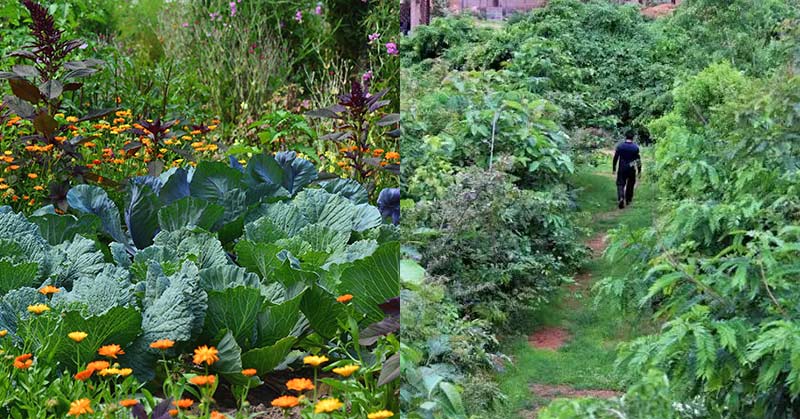Have you ever wondered why some plants thrive better untended in forests than in many human-owned gardens?
No one caters to the fruit trees or prunes the wild vegetable shrubs every week. No one bothers about watering them, covering them with mulch, manuring, or controlling pests. Absolutely no amount of human work goes into maintaining these wild plants, yet they flourish and bloom better than our garden plants ever could if we didn’t spend several hours each day maintaining them.
It’s simple. We may be going about modern farming the wrong way. Forest diversity provides plants with resilience against adverse climate conditions and environmental factors that affect the growth of plants [1]. It plays a major role in maintaining a productive ecosystem with natural stability. Our monoculture approach is increasingly rendering our soils unfit for agricultural practices after a few years. Flatly planting the same variety of crops in one garden will deplete the soil of certain essential nutrients and cause an excess of other compounds that may affect growth and yield.

Also, the lack of diversity makes plants more vulnerable to disease attack. Crop rotation is one of the best practices to prevent this depletion and give the soil a chance to replenish the necessary nutrients. However, a lot of commercial farmers find it difficult to keep up with the inconsistency in produce.
Read: The amazing farming preschool that teaches kids how to grow their own food
Forest gardens
Forest gardens are a man-made solution to the endless sea of problems created by monoculture. They are designed to mimic natural ecosystems, complete with dozens of varieties and species of plants to provide diversity and improve plant health and yield [2].
A renowned pioneer in forest gardening is Martin Crawford, a British author who is the founder and director of the Agroforestry Research Trust, an agroforestry non-profit based in the UK. According to Crawford, monoculture is slowly affecting the Earth’s soil and depleting its nutrients.
“What we think of as normal, in terms of food production is actually not normal at all. Annual plants are very rare in nature, yet most of our agricultural fields are filled with annual plants. It’s not normal. What’s normal is a more forested or semi-forested system,” he said in a video for National Geographic [3].
Mimicking natural ecosystems
In 1994, Crawford began growing his extensive forest garden with countless stems and seeds from dozens of plants and consistently added more varieties as the years wore on [4]. Today, he has over 500 edible plants thriving in a mind-blowing ecosystem in his garden.
Crawford explains that there are two categories of plants in the food forest.
The directly useful plants, which include fruit trees (common fruits and the rarer ones), all types of nuts, tuber plants, vegetables, timber and logs on which mushrooms grow.
There are also indirectly useful plants, also known as system plants which help the system function better. There are dozens of flowers to boost pollination, nitrogen-fixing plants which include several species of trees, and mineral accumulating plants.

“With such a diverse system, whatever happens with the weather, most of your crops will probably do fine. Some may fail, some may do better. That’s very important going into the future because we don’t know exactly what’s going to happen to our weather. So by having a diverse system, it gives you maximum resilience,” Crawford said.
Read: Hospital Grows Organic Rooftop Garden
There are about seven vertical levels of growth in a forest garden which include:
- Canopy trees,
- Smaller trees,
- Shrubs and bushes,
- Perennials,
- Groundcover layers,
- Root crops,
- Vines (climbers).
The different layers provide support, diversity, sunshade, wind and storm protection to one another.
The best thing about Crawford’s food forest is that it requires only a few hours of maintenance every month. The forest takes care of itself the same way a wild forest would. The different species of plants provide diversity to fight against diseases and withstand changes in climate.
It’s not as daunting as it seems
It may seem unreasonable to cluster so many species of plants into one enclosure but fret not. In the long run, it’s a lot easier and far more rewarding than the annual-crop frenzy everyone’s practicing these days.
Certainly, it’s going to take a lot of hard work in the early months and possibly years of cultivating the garden. It would also be initially cost-intensive to grow them into a stable level of self-maintenance, but after that, it would require very little maintenance. In Crawford’s words, the forest plants are “more like being out in nature than being in a cultivated garden.”
“It can seem overwhelming, there are so many species,” he says. “You shouldn’t let that stop you from starting a project, because you don’t have to know everything to begin with. Just start, plants some trees, and go from there.”
Watch Crawford’s insightful documentary below:
After the success of the short film, a feature-length documentary is now in the works, Edible Landscapes the movie.
Read More:
Tomatoes Hate Cucumbers: Secrets of Companion Planting and Popular Planting Combinations
How To Grow Your Own Garlic – It’s Easier than You Think!
Sources
- National Science Foundation. Plant diversity is key to maintaining productive vegetation. Science Daily. https://www.sciencedaily.com/releases/2012/05/120503200557.htm. Retrieved 31-01-2020
- https://trees.org/approach/?gclid=EAIaIQobChMI1qHewv-15wIVC2yGCh3hewI-EAAYASAAEgJL9PD_BwE
- National Geographic. A Forest Garden With 500 Edible Plants Could Lead to a Sustainable Future | Short Film Showcase. YouTube. https://www.youtube.com/watch?time_continue=175&v=Q_m_0UPOzuI&feature=emb_logo. Retrieved 31-01-2020
- Melissa Breyer. Forest garden with 500 edible plants takes a few hours of work a month. Tree Hugger. https://www.treehugger.com/lawn-garden/forest-garden-500-edible-plants-takes-few-hours-work-month.html. Retrieved 31-01-2020
- https://www.agroforestry.co.uk/

